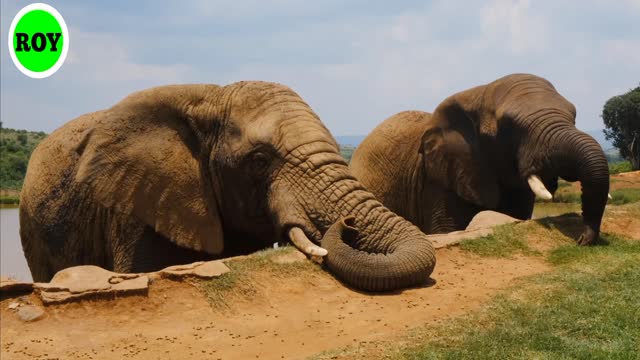Premium Only Content

Watch the video of the elephant largest land mammal.
Elephants are the largest terrestrial mammals. The only surviving offspring of the proboscidea (order proboscidea) (extinct breeds were mammoths etc.). The name "elephant" ("elephant" / "curry") is used to refer to the trunk as a hand. Three species: one two African (Luxodanta africana, Luxodanta cyclotis) and one Asian (Eliphas maximus). Adult (Asian only male) elephants have two long incisor teeth that make long ivory.
Elephants are group animals. Dalpati is the strongest tooth. Mothers and grandmothers surround the children in the center of the group. When the children grow up, they take their place outside the group. There are also defections. Mature dentists try to form their own team. During the "mast" season, young dentists become intoxicated by the excessive secretion of "mast glands" in front of the ear and attack the leader or other dentist or any ruler (such as a mahout). Then the leader may fight or try to hide. Male elephants without ivory are called Makna. They may be hiding among female elephants, and may reproduce unknowingly on the teeth.
The gestation period of elephants is the longest in the animal kingdom - about two years (22 months). Although the story says that elephants live for 100 years, elephants do not live for more than 60-70 years. Because six times in their lifetime (not twice as many as us) teething comes out, again chewing and decaying - the last set of teething sprouts in the sixties, which after decay, starvation death is inevitable.
The proboscis evolved by lengthening the nose of the aquatic ancestors of the proboscidia, as scientists thought that snorkeling in shallow water facilitated breathing [1]. Their closest mammal relatives are dugong, manati, sea cow, etc., which belong to the class Aquatic Syrenia. Their anatomical uniqueness is that after birth, their pleura (lining of the lungs) is filled with connective tissue (possibly with the dead space of a long trunk, so much negative air pressure is required to draw air that if the pleura cavity is empty, blood flows into it.
-
 6:34:08
6:34:08
MissesMaam
9 hours agoI'm Addicted | Sons of the Forest 💚✨
45.6K21 -
 11:22:12
11:22:12
a12cat34dog
11 hours agoALMOST HAVE ALL GUNS DIAMOND :: Call of Duty: Black Ops 6 :: SO MANY ZOMBIES CAMOS {18+}
37.3K -
 3:32:31
3:32:31
United Fight League
12 hours agoUFC 309 Watch Party w/ Rampage Jackson, Maycee Barber, Demi Bagby, and Harrison Rogers
100K6 -
 2:35:52
2:35:52
Jewels Jones Live ®
1 day agoELECTION OVER - LIES CONTINUE | A Political Rendezvous - Ep. 100
28K65 -
 3:59:18
3:59:18
GamerGril
14 hours agoPAGING ALL ZOMBOIZ | DEAD ISLAND 2
111K15 -
 42:24
42:24
MYLUNCHBREAK CHANNEL PAGE
22 hours agoA Century Gone
142K122 -
 38:22
38:22
Stephen Gardner
15 hours ago🔥HOLD ON! The RUMORS about Kamala are TRUE...
184K505 -
 1:22:44
1:22:44
Michael Franzese
1 day agoWill Trump’s Win Finally Convince Democrats to Stop The Woke Nonsense??
170K141 -
 8:27:07
8:27:07
MDGgamin
18 hours ago🔴LIVE- Rumble Gaming To The MOON - Variety of Games & Chatting - #RumbleTakeover
149K5 -
 27:24
27:24
Mr. Build It
5 days agoDECK DISASTER! How We Fixed a Botched Build
114K16